2019 MERCEDES-BENZ SL CLASS wheel
[x] Cancel search: wheelPage 47 of 330
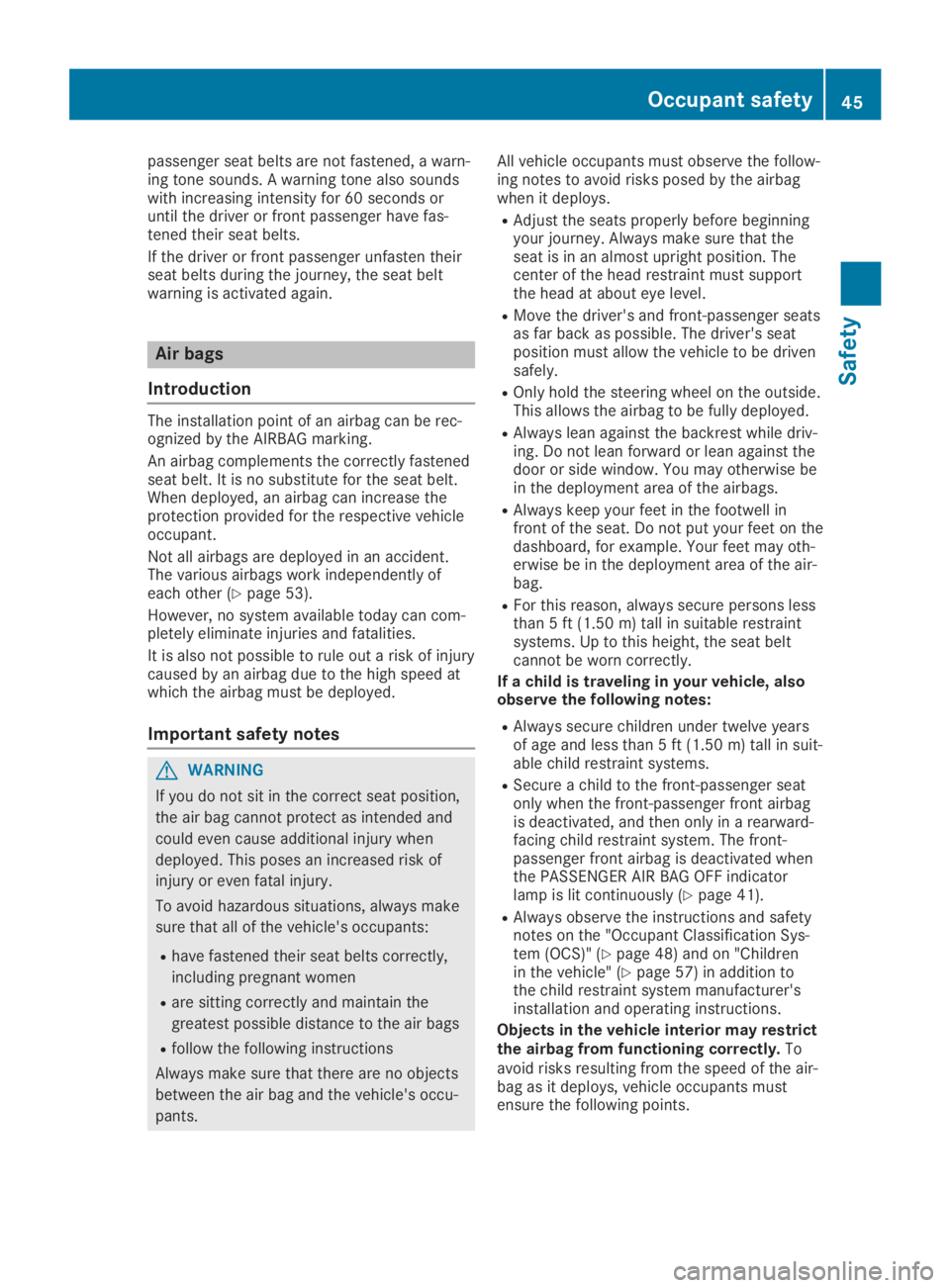
passenger seat belts are not fastened, a warn-ing tone sounds. A warning tone also soundswith increasing intensity for 60 seconds oruntil the driver or front passenger have fas-tened their seat belts.
If the driver or front passenger unfasten theirseat belts during the journey, the seat beltwarning is activated again.
Air bags
Introduction
The installation point of an airbag can be rec-ognized by the AIRBAG marking.
An airbag complements the correctly fastenedseat belt. It is no substitute for the seat belt.When deployed, an airbag can increase theprotection provided for the respective vehicleoccupant.
Not all airbags are deployed in an accident.The various airbags work independently ofeach other (Ypage 53).
However, no system available today can com-pletely eliminate injuries and fatalities.
It is also not possible to rule out a risk of injurycaused by an airbag due to the high speed atwhich the airbag must be deployed.
Important safety notes
GWARNING
If you do not sit in the correct seat position,
the air bag cannot protect as intended and
could even cause additional injury when
deployed. This poses an increased risk of
injury or even fatal injury.
To avoid hazardous situations, always make
sure that all of the vehicle's occupants:
Rhave fastened their seat belts correctly,
including pregnant women
Rare sitting correctly and maintain the
greatest possible distance to the air bags
Rfollow the following instructions
Always make sure that there are no objects
between the air bag and the vehicle's occu-
pants.
All vehicle occupants must observe the follow-ing notes to avoid risks posed by the airbagwhen it deploys.
RAdjust the seats properly before beginningyour journey. Always make sure that theseat is in an almost upright position. Thecenter of the head restraint must supportthe head at about eye level.
RMove the driver's and front-passenger seatsas far back as possible. The driver's seatposition must allow the vehicle to be drivensafely.
ROnly hold the steering wheel on the outside.This allows the airbag to be fully deployed.
RAlways lean against the backrest while driv-ing. Do not lean forward or lean against thedoor or side window. You may otherwise bein the deployment area of the airbags.
RAlways keep your feet in the footwell infront of the seat. Do not put your feet on thedashboard, for example. Your feet may oth-erwise be in the deployment area of the air-bag.
RFor this reason, always secure persons lessthan 5 ft (1.50 m) tall in suitable restraintsystems. Up to this height, the seat beltcannot be worn correctly.
If a child is traveling in your vehicle, alsoobserve the following notes:
RAlways secure children under twelve yearsof age and less than 5 ft (1.50 m) tall in suit-able child restraint systems.
RSecure a child to the front-passenger seatonly when the front-passenger front airbagis deactivated, and then only in a rearward-facing child restraint system. The front-passenger front airbag is deactivated whenthe PASSENGER AIR BAG OFF indicatorlamp is lit continuously (Ypage 41).
RAlways observe the instructions and safetynotes on the "Occupant Classification Sys-tem (OCS)" (Ypage 48) and on "Childrenin the vehicle" (Ypage 57) in addition tothe child restraint system manufacturer'sinstallation and operating instructions.
Objects in the vehicle interior may restrictthe airbag from functioning correctly.Toavoid risks resulting from the speed of the air-bag as it deploys, vehicle occupants mustensure the following points.
Occupant safety45
Safety
Z
Page 48 of 330
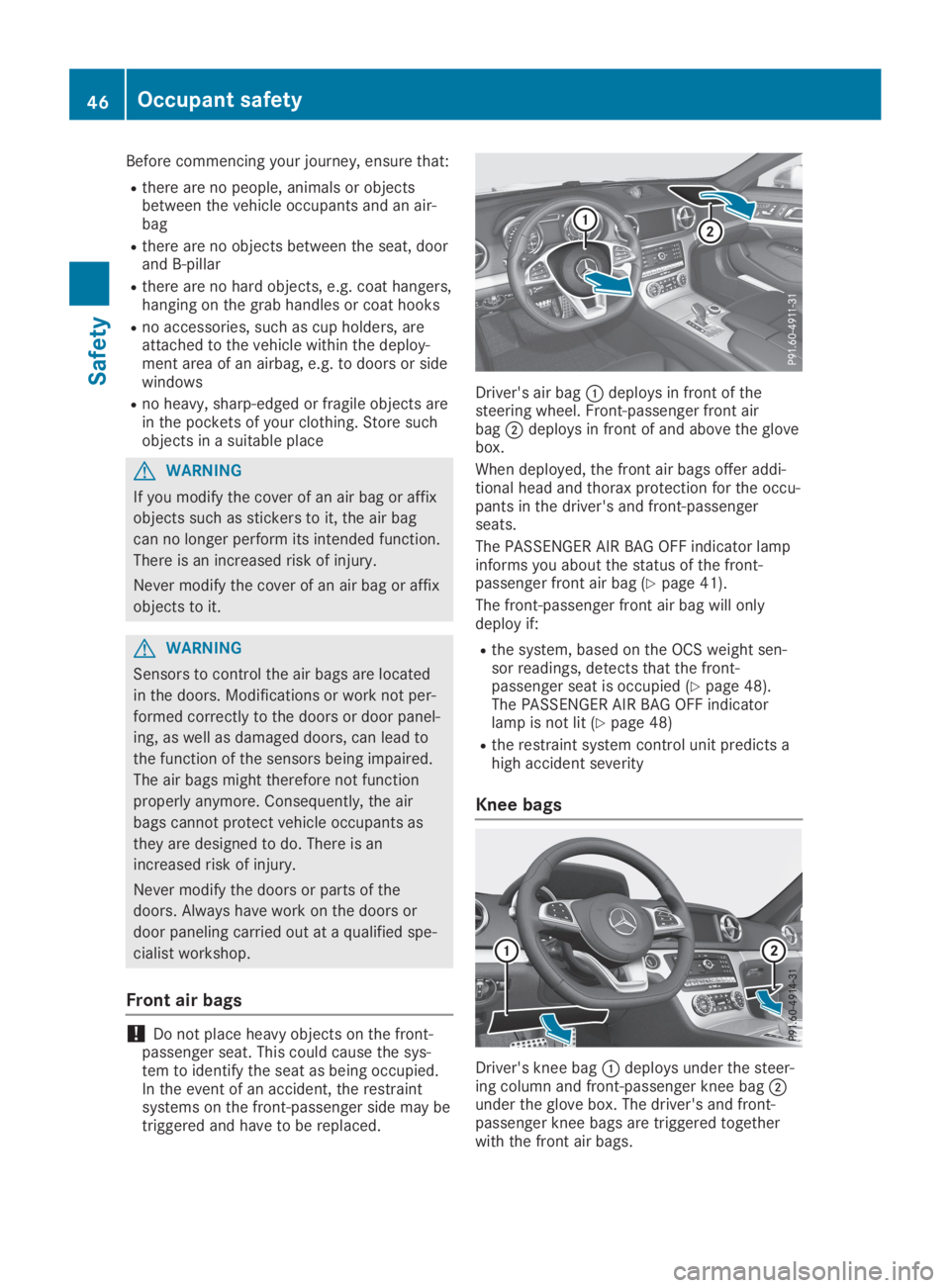
Before commencing your journey, ensure that:
Rthere are no people, animals or objectsbetween the vehicle occupants and an air-bag
Rthere are no objects between the seat, doorand B-pillar
Rthere are no hard objects, e.g. coat hangers,hanging on the grab handles or coat hooks
Rno accessories, such as cup holders, areattached to the vehicle within the deploy-ment area of an airbag, e.g. to doors or sidewindows
Rno heavy, sharp-edged or fragile objects arein the pockets of your clothing. Store suchobjects in a suitable place
GWARNING
If you modify the cover of an air bag or affix
objects such as stickers to it, the air bag
can no longer perform its intended function.
There is an increased risk of injury.
Never modify the cover of an air bag or affix
objects to it.
GWARNING
Sensors to control the air bags are located
in the doors. Modifications or work not per-
formed correctly to the doors or door panel-
ing, as well as damaged doors, can lead to
the function of the sensors being impaired.
The air bags might therefore not function
properly anymore. Consequently, the air
bags cannot protect vehicle occupants as
they are designed to do. There is an
increased risk of injury.
Never modify the doors or parts of the
doors. Always have work on the doors or
door paneling carried out at a qualified spe-
cialist workshop.
Front air bags
!Do not place heavy objects on the front-passenger seat. This could cause the sys-tem to identify the seat as being occupied.In the event of an accident, the restraintsystems on the front-passenger side may betriggered and have to be replaced.
Driver's air bag�Cdeploys in front of thesteering wheel. Front-passenger front airbag�Ddeploys in front of and above the glovebox.
When deployed, the front air bags offer addi-tional head and thorax protection for the occu-pants in the driver's and front-passengerseats.
The PASSENGER AIR BAG OFF indicator lampinforms you about the status of the front-passenger front air bag (Ypage 41).
The front-passenger front air bag will onlydeploy if:
Rthe system, based on the OCS weight sen-sor readings, detects that the front-passenger seat is occupied (Ypage 48).The PASSENGER AIR BAG OFF indicatorlamp is not lit (Ypage 48)
Rthe restraint system control unit predicts ahigh accident severity
Knee bags
Driver's knee bag�Cdeploys under the steer-ing column and front-passenger knee bag�Dunder the glove box. The driver's and front-passenger knee bags are triggered togetherwith the front air bags.
46Occupant safety
Safety
Page 58 of 330
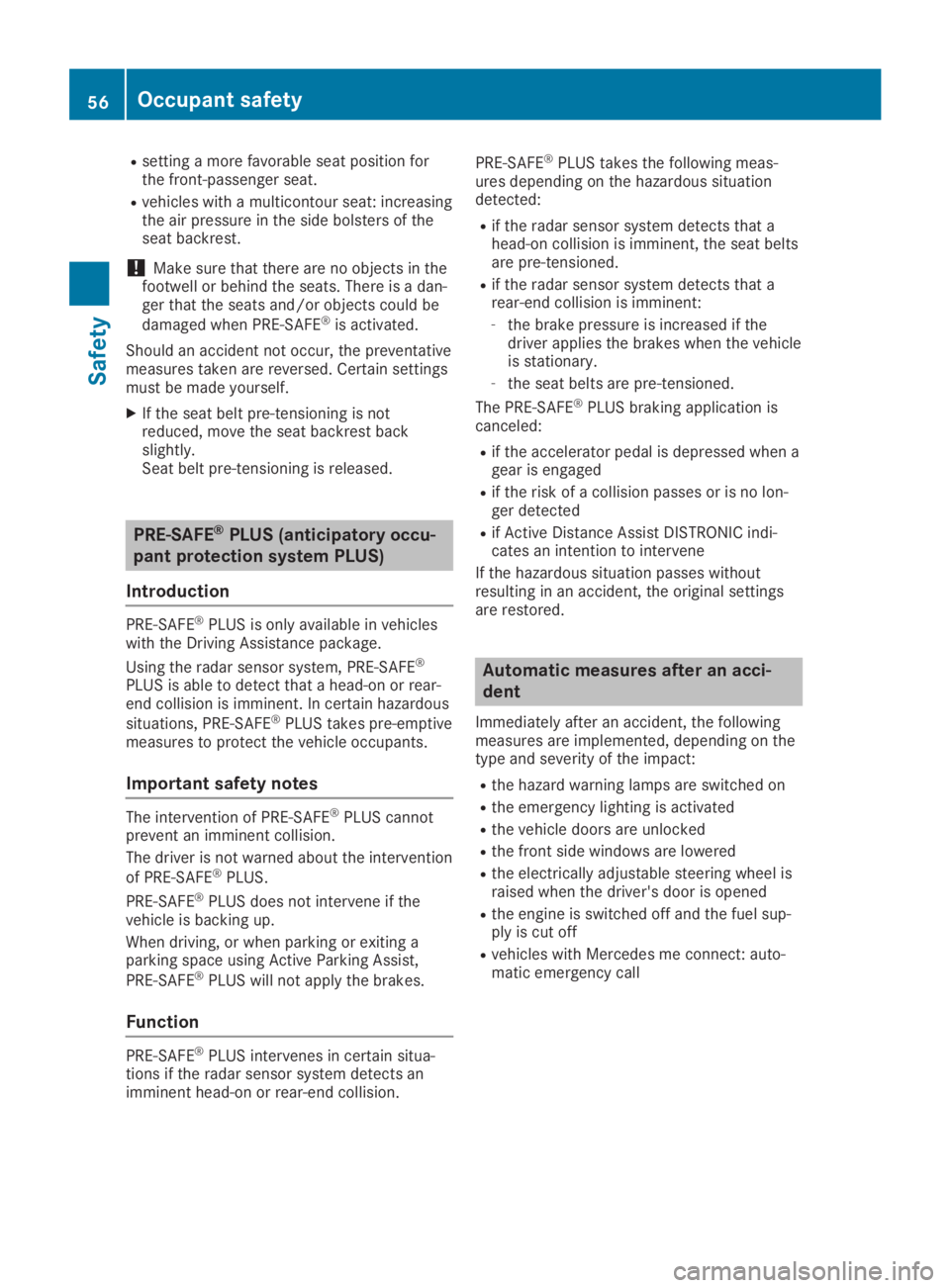
Rsetting a more favorable seat position forthe front-passenger seat.
Rvehicles with a multicontour seat: increasingthe air pressure in the side bolsters of theseat backrest.
!Make sure that there are no objects in thefootwell or behind the seats. There is a dan-ger that the seats and/or objects could be
damaged when PRE-SAFE®is activated.
Should an accident not occur, the preventativemeasures taken are reversed. Certain settingsmust be made yourself.
XIf the seat belt pre-tensioning is notreduced, move the seat backrest backslightly.Seat belt pre-tensioning is released.
PRE-SAFE®PLUS (anticipatory occu-
pant protection system PLUS)
Introduction
PRE-SAFE®PLUS is only available in vehicleswith the Driving Assistance package.
Using the radar sensor system, PRE-SAFE®
PLUS is able to detect that a head-on or rear-end collision is imminent. In certain hazardous
situations, PRE-SAFE®PLUS takes pre-emptivemeasures to protect the vehicle occupants.
Important safety notes
The intervention of PRE-SAFE®PLUS cannotprevent an imminent collision.
The driver is not warned about the intervention
of PRE-SAFE®PLUS.
PRE-SAFE®PLUS does not intervene if thevehicle is backing up.
When driving, or when parking or exiting aparking space using Active Parking Assist,
PRE-SAFE®PLUS will not apply the brakes.
Function
PRE-SAFE®PLUS intervenes in certain situa-tions if the radar sensor system detects animminent head-on or rear-end collision.
PRE-SAFE®PLUS takes the following meas-ures depending on the hazardous situationdetected:
Rif the radar sensor system detects that ahead-on collision is imminent, the seat beltsare pre-tensioned.
Rif the radar sensor system detects that arear-end collision is imminent:
-the brake pressure is increased if thedriver applies the brakes when the vehicleis stationary.
-the seat belts are pre-tensioned.
The PRE-SAFE®PLUS braking application iscanceled:
Rif the accelerator pedal is depressed when agear is engaged
Rif the risk of a collision passes or is no lon-ger detected
Rif Active Distance Assist DISTRONIC indi-cates an intention to intervene
If the hazardous situation passes withoutresulting in an accident, the original settingsare restored.
Automatic measures after an acci-
dent
Immediately after an accident, the followingmeasures are implemented, depending on thetype and severity of the impact:
Rthe hazard warning lamps are switched on
Rthe emergency lighting is activated
Rthe vehicle doors are unlocked
Rthe front side windows are lowered
Rthe electrically adjustable steering wheel israised when the driver's door is opened
Rthe engine is switched off and the fuel sup-ply is cut off
Rvehicles with Mercedes me connect: auto-matic emergency call
56Occupant safety
Safety
Page 62 of 330

Always secure animals properly when driv-
ing, for instance with a suitable pet carrier.
Driving safety systems
Overview of driving safety systems
In this section, you will find information aboutthe following driving safety systems:
RABS (Anti-lockBrakingSystem)(Ypage 60)
RBAS (BrakeAssistSystem) (Ypage 61)
RBrake Assist with cross-traffic function(Ypage 61)
RActive Brake Assist (Ypage 63)
RAdaptive brake lights (Ypage 65)
RESP®(ElectronicStabilityProgram)(Ypage 65)
REBD (ElectronicBrake forceDistribution)(Ypage 69)
RADAPTIVE BRAKE (Ypage 70)
RActive Brake Assist with cross-traffic func-tion (Ypage 70)
RSTEER CONTROL (Ypage 72)
Important safety notes
If you fail to adapt your driving style or if youare inattentive, the driving safety systems canneither reduce the risk of an accident noroverride the laws of physics. Driving safetysystems are merely aids designed to assistdriving.
You are responsible for maintaining the dis-tance to the vehicle in front, for vehicle speed,for braking in good time, and for staying inlane. Always adapt your driving style to suitthe prevailing road and weather conditions andmaintain a safe distance from the vehicle infront. Drive carefully.
The driving safety systems described onlywork as effectively as possible when there isadequate contact between the tires and theroad surface. Pay particular attention to theinformation regarding tires, recommendedminimum tire tread depths etc. in the "Wheelsand tires" section (Ypage 293).
In wintry driving conditions, always use wintertires (M+S tires) and if necessary, snow
chains. Only in this way will the driving safetysystems described in this section work aseffectively as possible.
ABS (Anti-lock Braking System)
General information
ABS regulates brake pressure in such a waythat the wheels do not lock when you brake.This allows you to continue steering the vehi-cle when braking.
The�%ABS warning lamp in the instrumentcluster lights up when the ignition is switchedon. It goes out when the engine is running.
ABS works from a speed of about 5 mph(8 km/h), regardless of road-surface condi-tions. ABS works on slippery surfaces, evenwhen you only brake gently.
Important safety notes
iObserve the "Important safety notes" sec-tion (Ypage 60).
GWARNING
If ABS is malfunctioning, the wheels could
lock when braking. The steerability and
braking characteristics would be severely
affected. There is an increased danger of
skidding and accidents.
Drive on carefully. Have ABS checked imme-
diately at a qualified specialist workshop.
When ABS is malfunctioning, other systems,including driving safety systems, will alsobecome inoperative. Observe the informationon the ABS warning lamp (Ypage 236) anddisplay messages which may be shown in theinstrument cluster (Ypage 206).
Brakes
XIf ABS intervenes:continue to depress thebrake pedal vigorously until the braking sit-uation is over.
XTo make a full brake application:depressthe brake pedal with full force.
If ABS intervenes when braking, you will feel apulsing in the brake pedal.
60Driving safety systems
Safety
Page 63 of 330
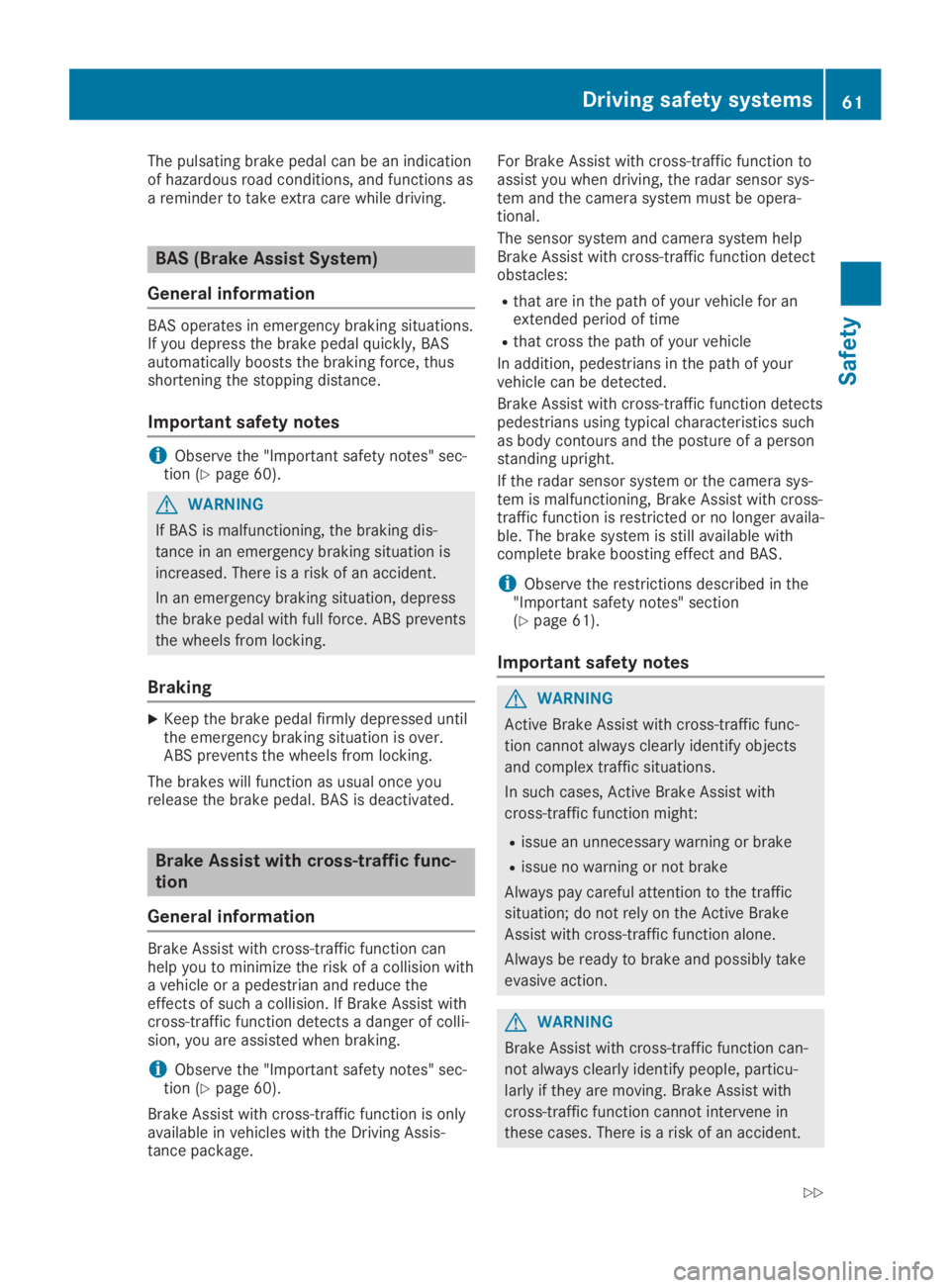
The pulsating brake pedal can be an indicationof hazardous road conditions, and functions asa reminder to take extra care while driving.
BAS (Brake Assist System)
General information
BAS operates in emergency braking situations.If you depress the brake pedal quickly, BASautomatically boosts the braking force, thusshortening the stopping distance.
Important safety notes
iObserve the "Important safety notes" sec-tion (Ypage 60).
GWARNING
If BAS is malfunctioning, the braking dis-
tance in an emergency braking situation is
increased. There is a risk of an accident.
In an emergency braking situation, depress
the brake pedal with full force. ABS prevents
the wheels from locking.
Braking
XKeep the brake pedal firmly depressed untilthe emergency braking situation is over.ABS prevents the wheels from locking.
The brakes will function as usual once yourelease the brake pedal. BAS is deactivated.
Brake Assist with cross-traffic func-
tion
General information
Brake Assist with cross-traffic function canhelp you to minimize the risk of a collision witha vehicle or a pedestrian and reduce theeffects of such a collision. If Brake Assist withcross-traffic function detects a danger of colli-sion, you are assisted when braking.
iObserve the "Important safety notes" sec-tion (Ypage 60).
Brake Assist with cross-traffic function is onlyavailable in vehicles with the Driving Assis-tance package.
For Brake Assist with cross-traffic function toassist you when driving, the radar sensor sys-tem and the camera system must be opera-tional.
The sensor system and camera system helpBrake Assist with cross-traffic function detectobstacles:
Rthat are in the path of your vehicle for anextended period of time
Rthat cross the path of your vehicle
In addition, pedestrians in the path of yourvehicle can be detected.
Brake Assist with cross-traffic function detectspedestrians using typical characteristics suchas body contours and the posture of a personstanding upright.
If the radar sensor system or the camera sys-tem is malfunctioning, Brake Assist with cross-traffic function is restricted or no longer availa-ble. The brake system is still available withcomplete brake boosting effect and BAS.
iObserve the restrictions described in the"Important safety notes" section(Ypage 61).
Important safety notes
GWARNING
Active Brake Assist with cross-traffic func-
tion cannot always clearly identify objects
and complex traffic situations.
In such cases, Active Brake Assist with
cross-traffic function might:
Rissue an unnecessary warning or brake
Rissue no warning or not brake
Always pay careful attention to the traffic
situation; do not rely on the Active Brake
Assist with cross-traffic function alone.
Always be ready to brake and possibly take
evasive action.
GWARNING
Brake Assist with cross-traffic function can-
not always clearly identify people, particu-
larly if they are moving. Brake Assist with
cross-traffic function cannot intervene in
these cases. There is a risk of an accident.
Driving safety systems61
Safety
Z
Page 65 of 330
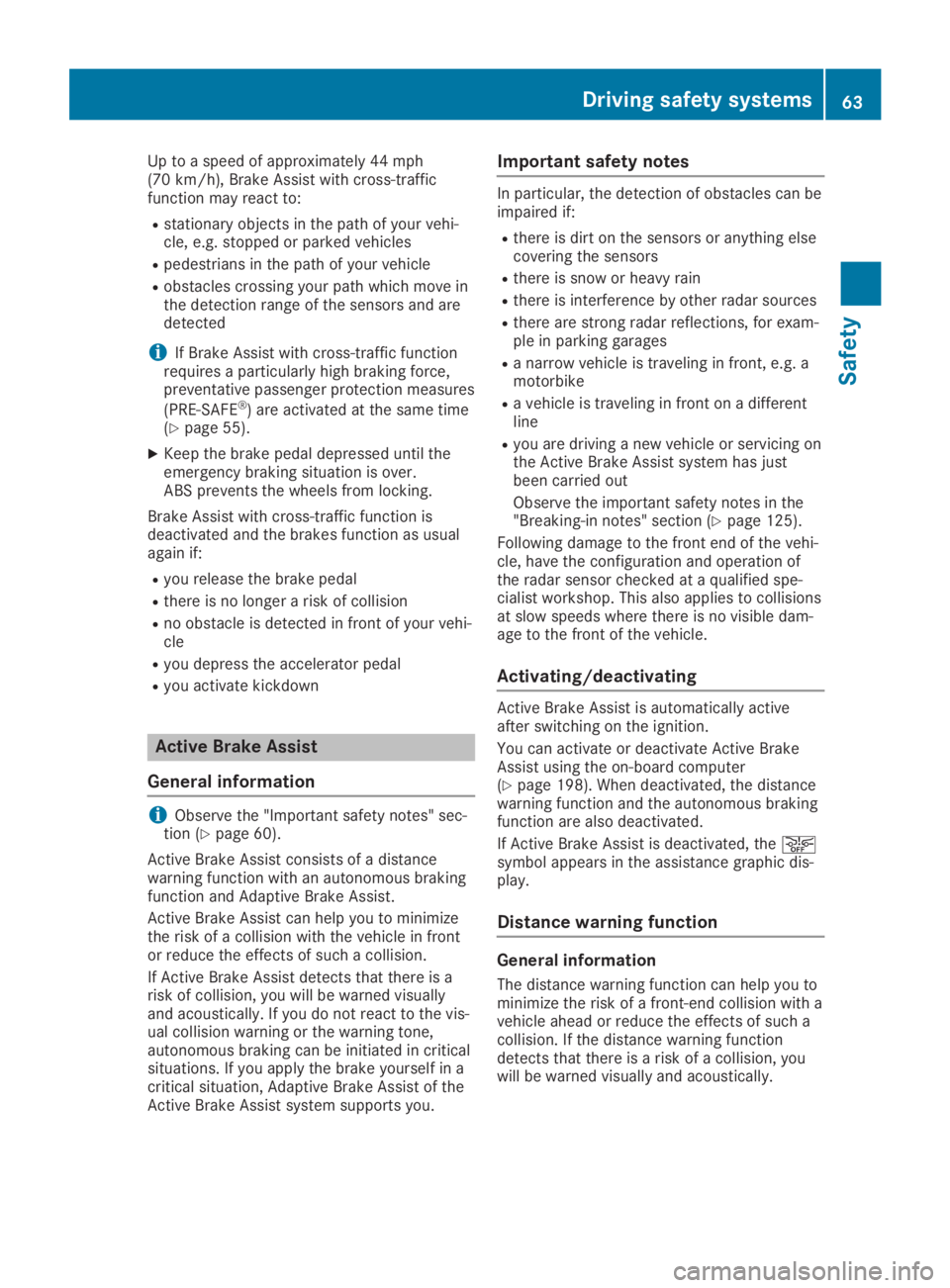
Up to a speed of approximately 44 mph(70 km/h), Brake Assist with cross-trafficfunction may react to:
Rstationary objects in the path of your vehi-cle, e.g. stopped or parked vehicles
Rpedestrians in the path of your vehicle
Robstacles crossing your path which move inthe detection range of the sensors and aredetected
iIf Brake Assist with cross-traffic functionrequires a particularly high braking force,preventative passenger protection measures
(PRE-SAFE®) are activated at the same time(Ypage 55).
XKeep the brake pedal depressed until theemergency braking situation is over.ABS prevents the wheels from locking.
Brake Assist with cross-traffic function isdeactivated and the brakes function as usualagain if:
Ryou release the brake pedal
Rthere is no longer a risk of collision
Rno obstacle is detected in front of your vehi-cle
Ryou depress the accelerator pedal
Ryou activate kickdown
Active Brake Assist
General information
iObserve the "Important safety notes" sec-tion (Ypage 60).
Active Brake Assist consists of a distancewarning function with an autonomous brakingfunction and Adaptive Brake Assist.
Active Brake Assist can help you to minimizethe risk of a collision with the vehicle in frontor reduce the effects of such a collision.
If Active Brake Assist detects that there is arisk of collision, you will be warned visuallyand acoustically. If you do not react to the vis-ual collision warning or the warning tone,autonomous braking can be initiated in criticalsituations. If you apply the brake yourself in acritical situation, Adaptive Brake Assist of theActive Brake Assist system supports you.
Important safety notes
In particular, the detection of obstacles can beimpaired if:
Rthere is dirt on the sensors or anything elsecovering the sensors
Rthere is snow or heavy rain
Rthere is interference by other radar sources
Rthere are strong radar reflections, for exam-ple in parking garages
Ra narrow vehicle is traveling in front, e.g. amotorbike
Ra vehicle is traveling in front on a differentline
Ryou are driving a new vehicle or servicing onthe Active Brake Assist system has justbeen carried out
Observe the important safety notes in the"Breaking-in notes" section (Ypage 125).
Following damage to the front end of the vehi-cle, have the configuration and operation ofthe radar sensor checked at a qualified spe-cialist workshop. This also applies to collisionsat slow speeds where there is no visible dam-age to the front of the vehicle.
Activating/deactivating
Active Brake Assist is automatically activeafter switching on the ignition.
You can activate or deactivate Active BrakeAssist using the on-board computer(Ypage 198). When deactivated, the distancewarning function and the autonomous brakingfunction are also deactivated.
If Active Brake Assist is deactivated, the�
Page 67 of 330
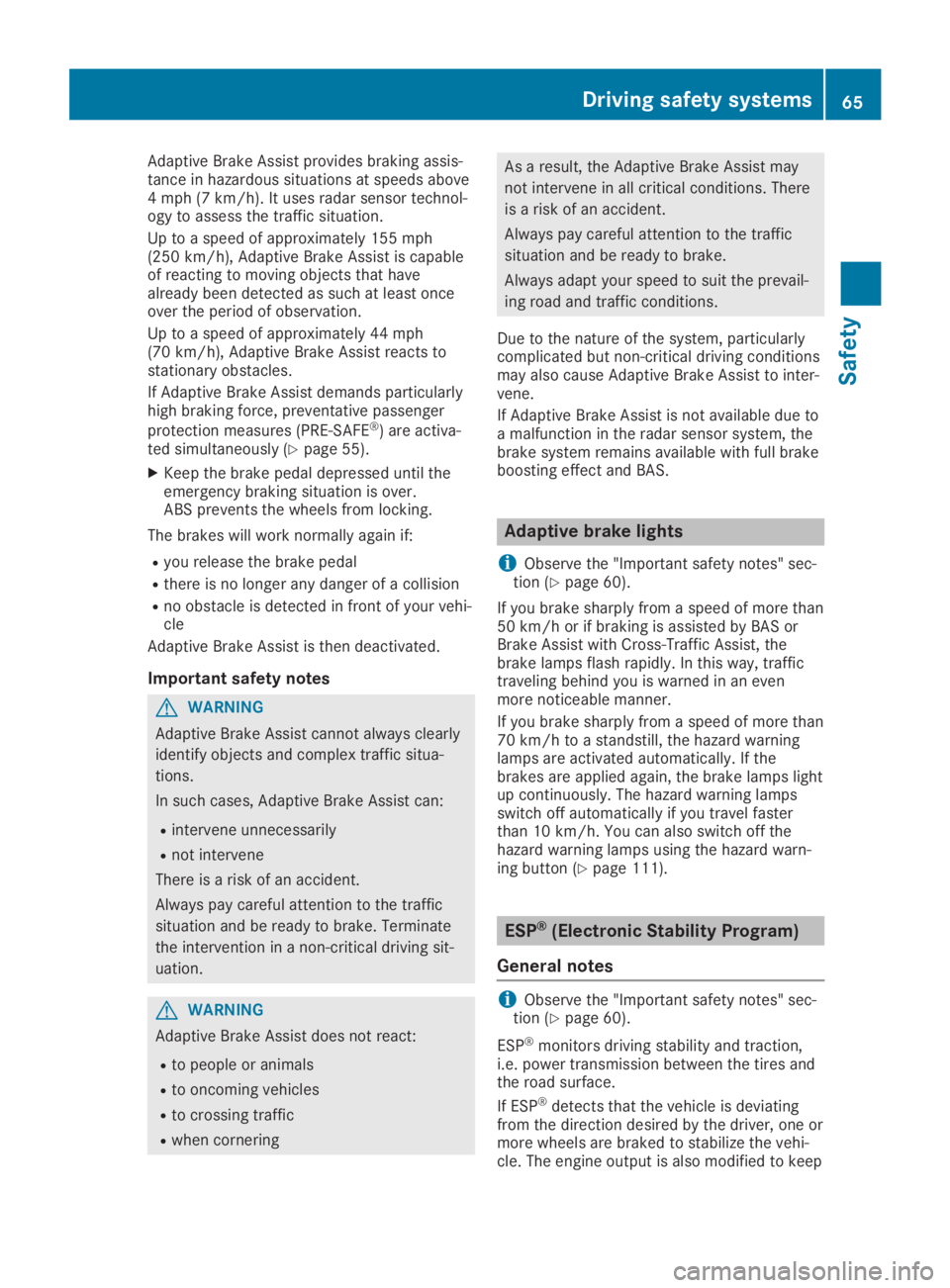
Adaptive Brake Assist provides braking assis-tance in hazardous situations at speeds above4 mph (7 km/h). It uses radar sensor technol-ogy to assess the traffic situation.
Up to a speed of approximately 155 mph(250 km/h), Adaptive Brake Assist is capableof reacting to moving objects that havealready been detected as such at least onceover the period of observation.
Up to a speed of approximately 44 mph(70 km/h), Adaptive Brake Assist reacts tostationary obstacles.
If Adaptive Brake Assist demands particularlyhigh braking force, preventative passenger
protection measures (PRE-SAFE®) are activa-ted simultaneously (Ypage 55).
XKeep the brake pedal depressed until theemergency braking situation is over.ABS prevents the wheels from locking.
The brakes will work normally again if:
Ryou release the brake pedal
Rthere is no longer any danger of a collision
Rno obstacle is detected in front of your vehi-cle
Adaptive Brake Assist is then deactivated.
Important safety notes
GWARNING
Adaptive Brake Assist cannot always clearly
identify objects and complex traffic situa-
tions.
In such cases, Adaptive Brake Assist can:
Rintervene unnecessarily
Rnot intervene
There is a risk of an accident.
Always pay careful attention to the traffic
situation and be ready to brake. Terminate
the intervention in a non-critical driving sit-
uation.
GWARNING
Adaptive Brake Assist does not react:
Rto people or animals
Rto oncoming vehicles
Rto crossing traffic
Rwhen cornering
As a result, the Adaptive Brake Assist may
not intervene in all critical conditions. There
is a risk of an accident.
Always pay careful attention to the traffic
situation and be ready to brake.
Always adapt your speed to suit the prevail-
ing road and traffic conditions.
Due to the nature of the system, particularlycomplicated but non-critical driving conditionsmay also cause Adaptive Brake Assist to inter-vene.
If Adaptive Brake Assist is not available due toa malfunction in the radar sensor system, thebrake system remains available with full brakeboosting effect and BAS.
Adaptive brake lights
iObserve the "Important safety notes" sec-tion (Ypage 60).
If you brake sharply from a speed of more than50 km/h or if braking is assisted by BAS orBrake Assist with Cross-Traffic Assist, thebrake lamps flash rapidly. In this way, traffictraveling behind you is warned in an evenmore noticeable manner.
If you brake sharply from a speed of more than70 km/h to a standstill, the hazard warninglamps are activated automatically. If thebrakes are applied again, the brake lamps lightup continuously. The hazard warning lampsswitch off automatically if you travel fasterthan 10 km/h. You can also switch off thehazard warning lamps using the hazard warn-ing button (Ypage 111).
ESP®(Electronic Stability Program)
General notes
iObserve the "Important safety notes" sec-tion (Ypage 60).
ESP®monitors driving stability and traction,i.e. power transmission between the tires andthe road surface.
If ESP®detects that the vehicle is deviatingfrom the direction desired by the driver, one ormore wheels are braked to stabilize the vehi-cle. The engine output is also modified to keep
Driving safety systems65
Safety
Z
Page 68 of 330
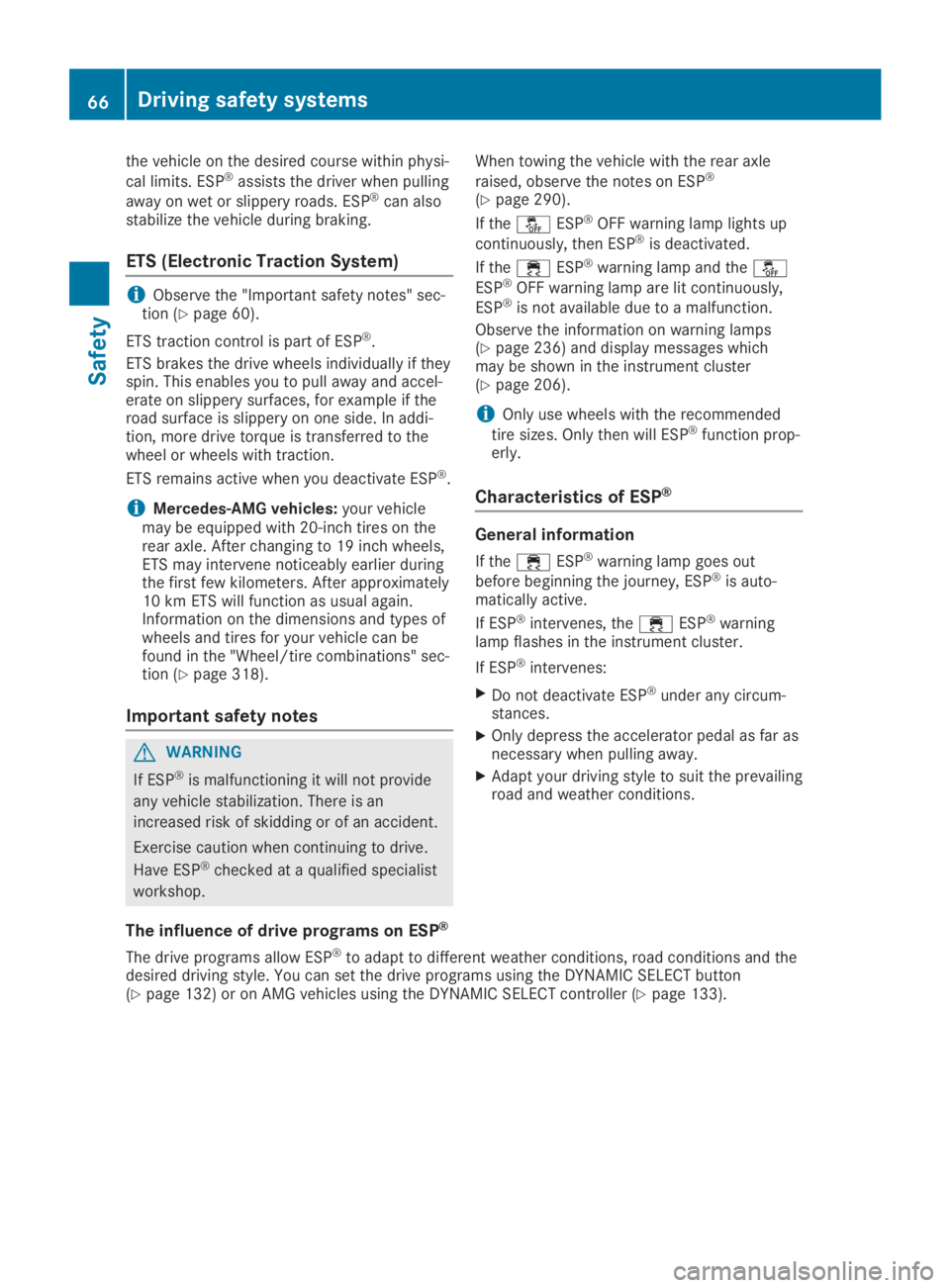
the vehicle on the desired course within physi-
cal limits. ESP®assists the driver when pulling
away on wet or slippery roads. ESP®can alsostabilize the vehicle during braking.
ETS (Electronic Traction System)
iObserve the "Important safety notes" sec-tion (Ypage 60).
ETS traction control is part of ESP®.
ETS brakes the drive wheels individually if theyspin. This enables you to pull away and accel-erate on slippery surfaces, for example if theroad surface is slippery on one side. In addi-tion, more drive torque is transferred to thewheel or wheels with traction.
ETS remains active when you deactivate ESP®.
iMercedes-AMG vehicles:your vehiclemay be equipped with 20-inch tires on therear axle. After changing to 19 inch wheels,ETS may intervene noticeably earlier duringthe first few kilometers. After approximately10 km ETS will function as usual again.Information on the dimensions and types ofwheels and tires for your vehicle can befound in the "Wheel/tire combinations" sec-tion (Ypage 318).
Important safety notes
GWARNING
If ESP®is malfunctioning it will not provide
any vehicle stabilization. There is an
increased risk of skidding or of an accident.
Exercise caution when continuing to drive.
Have ESP®checked at a qualified specialist
workshop.
When towing the vehicle with the rear axle
raised, observe the notes on ESP®
(Ypage 290).
If the�